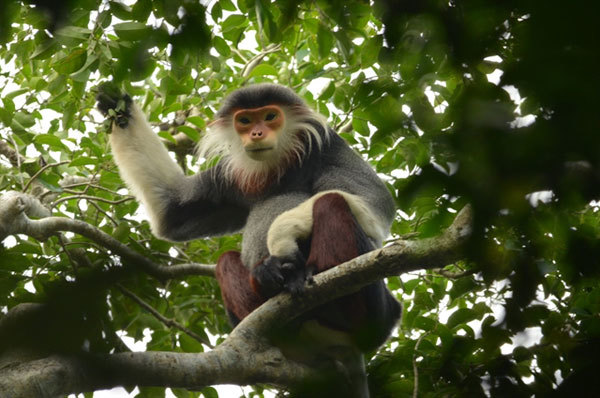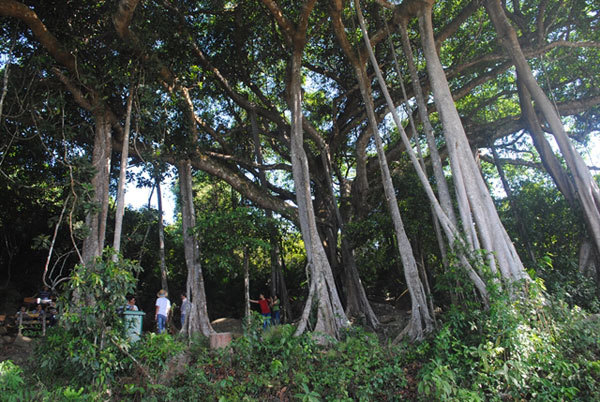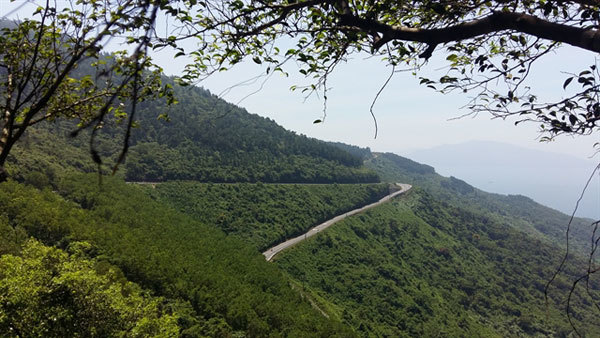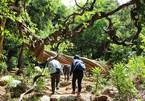 |
| A red-shanked douc langur (Pygathrix nemaeus) at the Son Tra Nature reserve of Da Nang. The central city has approved a Master Plan on biodiversity conservation in 2030. — Photo courtesy GreenViet |
The city said the plan, which was officially approved last week, would include funds of nearly VND100 billion (US$4.4 million) to cover the cost of conservation, forest protection and afforestation as well as establishing new reserves on an area of 43,722ha.
Following the plan, current nature reserves of Son Tra, Ba Na-Nui Chua and Nam Hai Van, or South Hai Van forest, will be key priorities for strict protection in biosphere reserves, natural landscape protection, herb and botanical gardens covering 37,534ha.
The Ba Na-Nui Chua nature reserve would be promoted as a National Park, while the Son Tra reserve and the South Hai Van special use forest will be kept as two nature reserves.
A core zone of the three reserves of Son Tra, Ba Na-Nui Chua and Nam Hai Van forest and 10,979ha of the Da Nang Bay would be a new biosphere reserve to protect endangered species.
The Master Plan also includes a botanical garden in the Ba Na-Nui Chua reserve and a 10ha herb garden in the Son Tra reserve.
Two lakes - Hoa Trung and Dong Xanh-Dong Nghe - will be protected landscape zones, including wetlands and endangered species conservation sites.
 |
| A 1,000-year-old tree in the forest of Son Tra in Da Nang City. More new reserves would be promoted in Da Nang in the coming years. — VNS Photo Cong Thanh |
The city assigned two departments for the Master Plan.
It said the protection of the nature reserves and promotion of new reserves and protected natural areas will aim to build rich biodiversity conservation corridors with neighbouring Thua Thien-Hue and Quang Nam as well as the central highlands and south central provinces in the future.
According to the city, the Master Plan on biodiversity conservation would help promote eco-tourism services while protecting the rich biodiversity of flora and fauna.
The Son Tra reserve, 10km from the city, is home to more than 1,300 red-shanked douc langurs - the world’s biggest population of the endangered primate listed by the International Union for Conservation of Nature (IUCN).
 |
| A view of the Hai Van Pass in the Nam Hai Van special use forest in Da Nang. The area was included in the city's Master Plan on biodiversity conservation. — VNS Photo Cong Thanh |
The reserve, which is 600m above sea level, is known for its rich biodiversity, with 387 animal species and 1,010 plant species.
Meanwhile, 626 animal species and 793 plant species, including the endangered northern buffed-cheeked gibbon and Edwards’s pheasant were reported living in the Ba Na-Nui Chua reserve.
The two reserves of Son Tra and Ba Na-Nui Chua are the ‘green lungs’ of Da Nang, supplying millions of tonnes of oxygen to residents and tourists.
Da Nang plans to become a ‘green’ and ‘smart’ city by 2025. VNS

Conservationist devoted to protecting primates
Having initially begun her involvement in wildlife protection as a volunteer with Education for Nature - Vietnam (ENV) in 2007, 34-year-old Le Thi Trang from Da Nang was named among the world’s top ten conservationists, called “Hotspot Heroes”

Sustainable protection needed for Son Tra Reserve
Human activities in the Son Tra Nature Reserve had changed the basic instincts of langurs and monkeys, while threatening the primate population with human-to-wildlife transmitted diseases, according to biologist Tran Huu Vy.